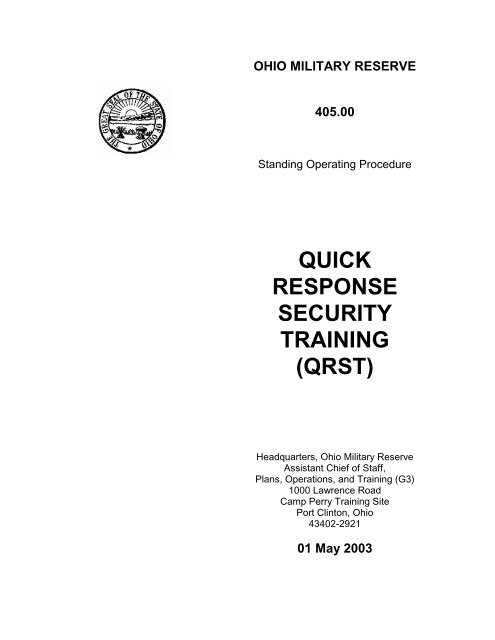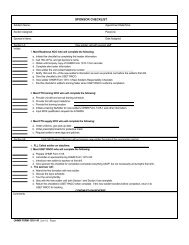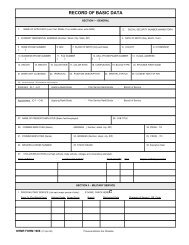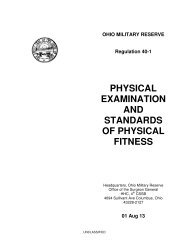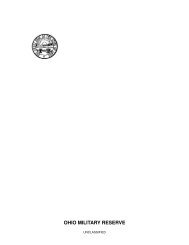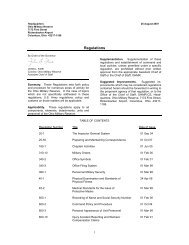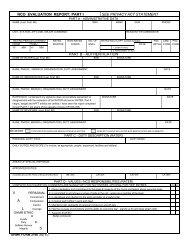quick response security training (qrst) - Ohio Military Reserve
quick response security training (qrst) - Ohio Military Reserve
quick response security training (qrst) - Ohio Military Reserve
Create successful ePaper yourself
Turn your PDF publications into a flip-book with our unique Google optimized e-Paper software.
OHIO MILITARY RESERVE405.00Standing Operating ProcedureQUICKRESPONSESECURITYTRAINING(QRST)Headquarters, <strong>Ohio</strong> <strong>Military</strong> <strong>Reserve</strong>Assistant Chief of Staff,Plans, Operations, and Training (G3)1000 Lawrence RoadCamp Perry Training SitePort Clinton, <strong>Ohio</strong>43402-292101 May 2003
OHIO MILITARY RESERVEAssistant Chief of Staff – Plans, Operations, and Training (G3)1000 Lawrence Road, Camp Perry Training SitePort Clinton, <strong>Ohio</strong> 43402-2921OHMR-G3 (QRST) 01 May 03MEMORANDUM FOR SEE DISTRIBUTIONSUBJECT: Quick Response Security Training (Teams) SOP 405.001. REFERENCES: None2. GENERALThis document provides the standards and doctrine for the organizing, <strong>training</strong> and employment ofQuick Response Security Training (QRST) teams within the <strong>Ohio</strong> <strong>Military</strong> <strong>Reserve</strong>.3. PURPOSEThe purpose of the QRST program is twofold:a. First, to provide the OHMR with highly trained personnel who are capable of rapid and flexible<strong>response</strong> to assist in the <strong>Military</strong> Support to Civil Authorities (MSCA) mission and who have skills and<strong>training</strong> beyond what is normally required of OHMR personnel;b. Second, the QRST program can fill the personal need of certain individuals to excel and tomove to a level of achievement beyond most of their peers. The recognition and status of the QRST tabprovides a tangible reward for the extra effort expended and assists in sustaining morale.4. SCOPEThis SOP is applicable to all personnel assigned or attached to the <strong>Ohio</strong> <strong>Military</strong> <strong>Reserve</strong>.5. RESPONSIBILITYIt is the responsibility of the local S3 to administer the local program and to coordinate <strong>training</strong> andemployment with the unit QRST coordinator and QRST Coordinator (G3).6. CONCEPTa. The concept of QRST is to provide personnel who are trained to be independent responders toan emergency activation to aid civil authorities or for physical <strong>security</strong> missions. While it is a given thatany military force called to aid civil authorities will be called only as a last resort and only after all otherresources are exhausted, there exists the possibility that upon the arrival of the military, the situation maybe entirely out of control or unchecked. The military may have little or no support from civil authorities.The situation may be fluid, highly confused, undefined and hazardous. Even if this is not the case, therewill exist the need for initial liaison personnel to arrive at the site in advance of the main force, meet withcivil authorities, evaluate the situation and the mission requests, locate dismount and/or deploymentareas, and communicate all this clearly to the incoming force commander.b. QRST personnel may work as:1). advance personnel for unit commanders,2). liaison teams3). intelligence teams4). damage assessment teams5). <strong>security</strong> coordination teams6). “pathfinder” teams for incoming units7). <strong>training</strong> teams for QRST trainees
OHMR-G3 (QRST)SUBJECT: Quick Response Security Training (Teams) SOP 405.00c. All QRST personnel will be volunteers. This is an additional individual qualification; there areno “QRST units” to which an individual may be assigned. Soldiers will complete QRST <strong>training</strong> in additionto their other, regular unit assignments unless relieved from regular responsibilities during their <strong>training</strong>period by their unit commander or attached to a QRST <strong>training</strong> team temporarily by higher authority.7. COORDINATORThe Corps QRST Coordinator will be a staff officer assigned to the G3 Section and may hold thisposition in addition to other assigned responsibilities. While he will be responsible for the development,execution and maintenance of the QRST program, he will have no direct command authority. The dutiesof the QRST Coordinator will include:a. Design of the QRST Team TO&E. This will be a guideline only; operational QRST Teams willbe constituted to fit the mission by the local commander.b. Develop, update and maintain <strong>training</strong> topics and standards for QRST qualification in keepingwith the current concept of the MSCA mission.c. Plan and supervise all initial qualification <strong>training</strong> and annual refresher <strong>training</strong> for QRSTpersonnel with the support of the G3/S3 sections. This includes the development, appointment, andsupervision of Area QRST Coordinators around the state who will be authorized to conduct <strong>training</strong> andre<strong>training</strong> locally.d. Review and approve or disapprove all applicants for QRST Training.e. Develop standard operations plans, in cooperation with the G3 and G5 Sections, for QRSTemployment in various MSCA scenarios. These plans will be provided to brigade and battalioncommanders.8. ELIGIBILITY AND ENROLLMENTVolunteers for enrollment in the QRST program must meet the following qualifications:a. Time In Service:1) Officers: minimum one year in service and have completed BOC.2) Enlisted: minimum one year in service have completed BELT.b. Must meet all OHMR health and physical fitness standards as described in OHMR-R 40-1 andmust be at least 5% below maximum allowable weights described in the height/weight chart contained inOHMR-R 40-1.c. Must have basic field uniform and individual equipment.d. Must have a letter of recommendation from their commander.e. Application form and procedures are located in Annex A.9. TRAININGa. All <strong>training</strong> must be conducted or supervised by QRST qualified personnel and will conform tothe specifications outlined in Annex B of this document. All <strong>training</strong> (except correspondence courses)conducted outside of regularly scheduled unit drills must be authorized by appropriate orders.b. Those portions of the QRST program which are self-administered correspondence coursesfrom the Federal Emergency Management Agency and the Army Institute for Professional Developmentmay be completed by the trainee at his own pace and on his own time.c. Classroom and field <strong>training</strong> requirements will be in addition to the student’s monthly drillobligation and duties within his home unit. In the event of a conflict of dates between the trainee’s normalunit drill and QRST <strong>training</strong>, unit drill will have precedence. The trainee’s commander may elect to excusethe trainee from normal drill obligations during part or all of the QRST <strong>training</strong> period but it is not required.d. The trainee will be permitted a period of eighteen consecutive months to complete all <strong>training</strong>requirements. Failure to do so will result in the trainee being dropped from the program. The trainee mayre-apply for enrollment one year after having been dropped; credit will not be given for portions of2
OHMR-G3 (QRST)SUBJECT: Quick Response Security Training (Teams) SOP 405.00<strong>training</strong> previously completed. Under extenuating circumstances, the QRST Coordinator (G3) may grantone or more extensions to the eighteen month time frame.10. DISTINCTIVE TABThe QRST tab (see Annex C) will be awarded at an appropriate ceremony to those personssuccessfully completing all <strong>training</strong> requirements. The tab will be embroidered in the traditional militarypolice colors; the background will be green with the lettering and border golden yellow. It will be worndirectly above the OHMR shoulder patch on the left sleeve with the lowest points touching the top of theshoulder patch. The tab will be worn on the Army service green coat, the Class “C” shirt , and the fieldjacket. Retirees may wear the tab directly above and touching the retiree’s shoulder patch.11. EMPLOYMENTa. As stated earlier, the mission oriented purpose of the QRST program is to provide thecommander with highly trained personnel who are capable of rapid and flexible <strong>response</strong> to assist in a<strong>Military</strong> Support to Civil Authorities (MSCA) mission and who have skills and <strong>training</strong> beyond what isnormally required of OHMR personnel. They can be the commander’s “eyes and ears” on site, acting asan advance party and liaison between civil authorities and the incoming unit. They may be the first OHMRpersonnel to meet with the civilian Incident Commander; may select dismount and assembly points, andmay locate the initial CP. Because they will be first on the scene after the request for military support hasbeen made (and presumably after the situation has overtaxed civilian resources) they must be preparedfor the unlikely event that they will have to respond to problems or threats with little or no support. Their<strong>training</strong> is designed to give them a broad base of knowledge, keep their thinking flexible and optionoriented,and give them confidence in their abilities.b. There will be no QRST units, only QRST qualified personnel scattered throughout variousunits. Each S-3 will maintain a current list of QRST qualified personnel within the unit. A unit QRSTcoordinator may be assigned, if desired.c. Upon activation for a MSCA mission, the unit commander may chose to activate a QRSTteam, especially if no OHMR liaison officer is at the place where the unit is going. At the commander’sdirection, the S-3 (or unit QRST coordinator) will contact the required number of QRST personnel fromwithin the activated unit and direct them to activate immediately. They will be given instructions on:1). who is going and who is the team leader;2). where they are to meet and where they are to go;3). what they are supposed to do on arrival and what information is needed;4). when they are to arrive on the scene;5). how they are to travel and how they are to report information to the S3d. QRST teams should consist of three to six persons, depending on the size and scope of themission. The team should be totally self sufficient, carrying rations, water, and shelter for forty-eighthours.e. QRST teams may be used as physical <strong>security</strong> specialists for protecting facilities, property, orpersons. This may be in conjunction with a MSCA mission or a solely military mission. They may assumethe <strong>security</strong> mission totally or they may be used as a <strong>training</strong> cadre and/or supervisory element for othertroops.f. QRST teams may be utilized as damage assessment teams. It is recommended that prior tosuch employment, they complete a damage assessment course through FEMA, the Red Cross or asimilar agency, but it is not mandatory.g. QRST teams may be utilized as “pathfinder” teams. In this role they would locate and mark asafe, passable and secure avenue of approach to the disaster area for the incoming force. It may benecessary to utilize some QRST personnel as guides for entry into particularly hazardous or complicatedareas.h. Upon completion of their assignment, the QRST team is disbanded at the direction of thecommander who authorized their employment and the soldiers immediately returned to their units.3
OHMR-G3 (QRST)SUBJECT: Quick Response Security Training (Teams) SOP 405.00i. The responsible G3 will file an after action report concerning the QRST activity with the QRSTCoordinator (G3) not later than fourteen days after the activity.Annexes:A - Enrollment FormsB - Course SynopsisC - QRST TabGENE A. DALEColonel, GSAssistant Chief of Staff, G3OFFICIAL:RICHARD B. IOTTLieutenant Colonel, GSSecretary to the General Staff4
ANNEX A (Enrollment Forms) to SOP 405.00 (Quick Response Security Training [QRST])QUICK RESPONSE AND SECURITY TRAINING (QRST)ENROLLMENT APPLICATIONAPPLICATION INSTRUCTIONS1. Read all requirements and instructions. Be sure you understand them completely before beginning.2. Complete Sections 1 through 8 of the application. Incomplete applications will not be accepted. Allinformation submitted will be kept confidential.3. Have you commanding officer sign Section 8 of the application. You will also need a letter ofrecommendation from your commander.4. Forward the completed application and the letter of recommendation to the G3 QRST Coordinator.MAJ Steven W. WeberG3 QRST Coordinator, OHMR5307 Cleander DriveCincinnati, <strong>Ohio</strong> 452385. You will be informed in writing of your approval or disapproval and your starting date for QRST <strong>training</strong>.You will also receive orders authorizing you to attend the next available QRST <strong>training</strong>.REQUIREMENTSVolunteers for enrollment in the QRST program must meet the following requirements for entry:1. Time-in-service:a. Officers: minimum one year in service and have completed BOC.b. Enlisted: minimum one year in service and have complete BELT.2. Must meet all OHMR health and physical fitness standards as described in OHMR-R 40-1 and must beat least 5% below the maximum allowable weights described in the height/age/weight chart contained inOHMR-R 40-1.3. Must have basic field uniform including cold and wet weather clothing.4. Must have basic field equipment including load-bearing equipment, canteen, rucksack, sleeping bag,shelter, and incidental items.5. Must be recommended in writing by commanding officer.6. Must be willing to devote necessary time to complete <strong>training</strong> (currently approximately 180 credit hours)within eighteen months, understanding that this may be in addition to regular drill schedules.7. Must have the ability to travel to various locations within the state for <strong>training</strong>.A-1
OHIO MILITARY RESERVEQUICK RESPONSE AND SECURITY TRAINING (QRST)ENROLLMENT APPLICATION1. APPLICANT:____________________________________________________________________________________Last Name First Name MI____________________________________________________________________________________Rank SSN DOB____________________________________________________________________________________Address City/Town ZIP+4____________________________________________________________________________________Home Phone Work Phone Pager or Cell Phone (circle one)____________________________________________________________________________________E-mail Address2. PERSONAL INFORMATION:In case of emergency contact:____________________________________________________________________________________Name____________________________________________________________________________________Address City/Town ZIP+4____________________________________________________________________________________Home PhoneWork Phone3. ASSIGNMENT DATA:____________________________________________________________________________________Brigade Battalion Company____________________________________________________________________________________Unit Address City/Town ZIP+43. PRIOR SERVICE: ____ Yes ____ No____________________________________________________________________________________BranchService Number____________________________________________________________________________________AssignmentDates of ServiceA-2
4. MEDICAL HISTORY:1. Do you have any medical condition or handicap which will prevent you fromsuccessfully participating in the <strong>training</strong> prescribed for QRST?2. Do you have any medical condition or handicap which may be made worseby your participation in the <strong>training</strong> prescribed for QRST?Yes ____ No ____Yes ____ No ____3. Are you currently taking any prescribed medication(s)? Yes ____ No ____4. Are you under a doctor’s care? Yes ____ No ____5. Do you meet the requirements of OHMR-R 40-1 Yes ____ No ____6. Is your weight currently at least 5% less than the maximum allowable weightpermitted for your height/age group as described in OHMR 40-1?Yes ____ No ____5. SERVICE RECORD:DOE __________________ DOR _________________ PMOS _________ SMOS ________Training completed (check those that apply or those waived IAW OHMR SOP 203.00, 204.00):BELT _____ 95B _____ BNCOC _____ ANCOC _____ BOC _____6. SPECIAL SKILLS (civilian or military, if applicable)________________________________________________________________________________________________________________________________________________________________________7. APPLICANT’S STATEMENT:I hereby certify that I have read this application and that the information contained hereon isaccurate. I understand that providing misleading or false information will result in my immediate dismissalfrom the QRST program and that I may be subject to administrative disciplinary action.____________________________________________________________________________________Signature Rank Date8. COMMANDER’S APPROVAL____________________________________________________________________________________Signature Printed Name Rank DateNote: in addition to this approval, a letter of recommendation from the applicant’s commanding officer must be submitted with thisapplication.(for office use only)9. QRST COORDINATORApplication has been reviewed and applicant has beenApproved _____ Disapproved _____for enrollment in the QRST program. Applicant’s first <strong>training</strong> session will be held at the location, time andplace noted on the following page. The applicant will have eighteen months from that date to complete allrequired <strong>training</strong> IAW OHMR SOP 405.00.A-3
Initial <strong>training</strong> to take place at:______________________________________________________________________________________________________________________________________________________________________________________________________________________________________________________________________________________________________________________Time and date of initial <strong>training</strong>: __________________________________________________________QRSTQuick Response and Security TrainingA-4
ANNEX B (Course Synopsis) to SOP 405.00 (Quick Response Security Training [QRST])QRSTQuick Response and Security Training180 credit hoursCORRESPONDENCE COURSES1. US Army <strong>Military</strong> Police Law EnforcementOperations Subcourse (MP1006)Provides <strong>training</strong> in <strong>Military</strong> Police responsibilities forprocessing offenders, discusses how to identify andreact to serious incidents and the supervision of abomb threat and a hostage situation; discusses thelegality of searches; provides discussions on the useof force; supervision of enforcement of trafficregulations: and discusses responsibility for the<strong>security</strong> of a crime scene to include the protection ofevidence and recording of the scene. 10 credithours.2. US Army Physical Security CourseProvides MP officers and enlisted personnel withgeneral knowledge of physical <strong>security</strong> to includephysical <strong>security</strong> planning, installation <strong>security</strong>, area<strong>security</strong> and material control. Consists of foursubcourses, total of 20 credit hours.3. US Army Civil Disturbance CourseProvides MP officers and enlisted personnel withsufficient knowledge and skills to perform dutieswhen deployed during a civil disturbance, includingunderstanding behavior of a crowd; legal aspects;news media relationship; interrelationship of local,state, and federal authorities, supervision of crowdcontrol formations; and use of force, personnel,logistical and operational planning to control civildisturbances. Consists of two subcourses, total of 10credit hours,4. US Army <strong>Military</strong> Operation on Urban TerrainSubcourse (IN0410)Identify the phases of deliberate entry Into an urbanarea. Plan operations and <strong>security</strong> for platoon levelentry Into urban environment. Identify the proceduresfor securing buildings. Plan and identify defensiveand observation positions. Be aware of specialcomplications of urban operations. 5 credit hours.5. FEMA Emergency Preparedness Course (HG3)This course contains information about natural andtechnological hazards and disasters and national<strong>security</strong> Issues. Participants are led through thedevelopment of personal emergency preparednessplans and are encouraged to become involved In thelocal emergency preparedness network through anexplanation of the local, state and federal system.Text Is accompanied by illustrations, maps, charts,and diagrams. 15 credit hours.TASKS6. Emergency FirefightingOrientation to the use of typical hoses, nozzles andhydrants; operation of typical pumper truck, basicprocedures for stopgap firefighting and fire safety.Must include hands on experience. Minimum 4 hours.7. Emergency Water SafetySimple lifesaving techniques for self and buddy,proficiency tests: survival of unexpected immersion (10' leap into deep water wearing field equipment withload; ditch gear swim to safety), 50 yard fully clothedswim, 25 yard clothed rescue tow, tread water 15minutes (boots removed), IS minute survival float.Minimum 4 hours.8. First AidBasic first aid, first responder techniques, CPR, selfhelp and buddy aid. Minimum 3 hours.9. MP Patrol TechniquesMP patrolling techniques in urban and rural areas, asMID elements or paired with civilian police, undervarious conditions, mounted and dismounted, inteams and in squads. Must include practicalapplication of dismounted patrol. Minimum 4 hours.10. Conduct <strong>Military</strong> Police OperationsParticipate as a member of a <strong>security</strong> force activelyconducting continuous <strong>security</strong> operations at a facilityor location for a period of twelve hours, a portion ofwhich must be in darkness. Minimum 12 hours.11. CommunicationsOperation and operator's maintenance of PRC-25/77,VRC-10, VRC-12 series, GRC-160, VRC-46, RT-524,RT-246 and R-442 radios and T/A PT-1 and T/A-312phones; erection and operation of RC-292 Antenna.Must be hands on experience. Will Include radioprocedures, CEOI, and troubleshooting. Will includediscussion of SINGARS systems also. Minimum 8hours.A-5
12. Prepare a Situation Report (SITREP)Prepare an operational situation report in accordancewith OHMR MSOP 86. Minimum I hour.13. Prepare a Spot ReportPrepare a spot report in accordance with OHMRMSOP 86. Minimum I hour.14. Prepare a Patrol PlanPrepare a patrol plan, without overlays, in accordancewith OHMR MSOP 86. Minimum I hour.15. Conduct a Route-ReconConduct a recon and prepare a written report of atleast two miles of roadway using proper symbols andnomenclature. Minimum 3 hours.16. Establish and Operate a Traffic Control Point(TCP)Select a site, establish <strong>security</strong> and set up andoperate a traffic control on a two lane road with twoway traffic. Minimum 2 hours.17. Designate Location and Establish Security forDismount Point (DP)Select an area based on safety considerations andtype of traffic to be handled, establish <strong>security</strong> andtraffic control plan. Minimum 2 hours.18. Convoy SecurityLearn basic principles of convoy <strong>security</strong>, SOPs andresponsibilities. Understand convoy chain ofcommand for <strong>security</strong> and for operation. Minimum 1hour.19. Conduct Convoy Movement Through a DefileConduct one way traffic through a defile or around anobstacle using two different methods to controlmovement and keep control, both for accountabilityand <strong>security</strong>. Minimum 1 hour,20. Establish and Operate an Emergency HelicopterLanding Zone (LZ)Learn requirements for the establishment of anemergency helicopter landing zone as required bycivilian medivacs. Learn method and hand signals forground coordination of landing/takeoff as well ashazards of working around helicopters. Minimum 2hours.21. Establish Interior/Exterior Security of a BuildingClassroom instruction and hands on practiceincluding but not limited to gate <strong>security</strong>,challenge/password techniques, perimeter patrol,two-man rule, ID/key <strong>security</strong> methods, lightingrequirements, establishing physical <strong>security</strong> of abuilding by safely searching, locating and removingunauthorized persons or victims/survivors, use offorce, personnel/vehicle control, <strong>security</strong> forceresponsibility and deployment. Minimum 8 hours.22. Map Reading and Land Navigation/SearchTechniquesUse of military grid reference system, use of thelensatic compass, Plotting coordinates and azimuths,resection and triangulation, area search patterns andtechniques, following a course through difficultterrain, coordinating rescue efforts from a specificsite. Must include hands-on <strong>training</strong> and day andnight execution of compass course. Minimum 8hours.23. NBC/Use of Protective Mask/Gas RoomHow to protect yourself against common NBChazards, DOT Hazardous Material Index, use andcare of gas mask, operating under masked conditions(student will enter a gas filled room, remove, replaceand clear mask, then set up a field radio; establishradio contact and the perform several simple motorskill coordination tasks. Minimum 4 hours.24. Rappelling TechniquesBasic instruction on rappelling techniques to includerope safety, knots, swiss seats, use of descender,rappelling with equipment load and general safety.Must include lowrappel (10), high rappel (30) and free rappel.Individual must demonstrate ability to rig ropes andconduct rappel alone (although a belayer will alwaysbe used in <strong>training</strong> situations). Minimum 5 hours.25. Unarmed Self DefenseUse of basic unarmed self defense techniquesagainst physical assault and methods for subduing anattacker or suspect. Minimum 2 hours.26. Apprehension, Body Searches and HandironTechniquesSafe procedure for the apprehension ofsuspects/offenders, basic body searches for weaponsor contraband, use of handirons, alone or in teams.Minimum 2 hours.27. Emergency Survival Techniques for ColdWeather/Hot WeatherSurvival techniques for use If lost or stranded,especially in cold or sub-zero weather, field expedientdirection finding; finding water, building a temporaryshelter; fire making. Establish and spend night inminimized camp in actual winter conditions. Minimum18 hours.28. Operate an Observation PostMethod and techniques of operating an observationor monitoring post. Minimum 1 hour.29. Identify Conventional/Unconventional ExplosivesRecognize various types of explosives and explosivedevices and how they can be utilized against thecivilian population or <strong>security</strong> force personnel andfacilities. Minimum 2 hours.B-2
30. Conduct a Building SearchMethods and safety techniques for searching abuilding for victims, survivors, explosives, contraband,etc. Must be done with hands on practice. Minimum 2hours.31. Understand Camouflage/ConcealmentTechniquesUnderstanding the art of camouflage/deception ofpersonnel and equipment through practicalapplication as it may be used against members of a<strong>security</strong> team. Minimum 3 hours.32. Uniform and Equipment RequirementsReview of uniform standards and requirements,polices regarding use of equipment and unit SOPsregarding readiness. Minimum 1 hour.33. Prepare a Warning OrderThe steps to preparing a warning order, the factswhich must be covered and the timing relative to themission; a warning order will be prepared. Minimum Ihour.34. Instruct a 30 Minute Class on Any of the AboveSubjectsLearn backward planning technique, Prepare TrainingOutline, gather resources, conduct class and doTraining Evaluation. Minimum 3 hours.35. 16 km Timed Team Hike with LoadParticipate in a 16km (10 mi) hike utilizing establishedtrails, roads and cross country navigation techniqueswith map and compass, Radio contact will directever-changing route and obstacles. Field equipmentand rucksack with 30 lb. load will be carried tosimulate food, medical supplies or other rescueequipment. Time limit will be 6 hours, however, thismay be adjusted up or down depending on theavailable terrain.36. 3km Timed Individual RunRun on paved or graded path for a distance of 3km(1.87 mi) in comfortable PT clothes. Time limit: 25minutes.37. Problem SolvingParticipate in a series of team exercises such as thenegotiation of an obstacle course which no oneperson can complete alone and which can only beaccomplished by teamwork and using creative,improvised aids. Minimum 5 hours.READINESS37. Maintain 90% Drill Attendance for One YearB-3
ANNEX C (QRST Tab) to SOP 405.00 (Quick Response Security Training [QRST])1. DISTINCTIVE TABThe QRST tab (see Figure 1) will be awarded at an appropriate ceremony to those personssuccessfully completing all <strong>training</strong> requirements.2. DESIGNThe tab will be made in the traditional arc shape and will be 2 1/2” between the lower points; thebody of the tab will be 11/16” in vertical thickness. It will be embroidered in the traditional military policecolors; the background will be green with the lettering and border golden yellow.3. WEARThe tab will be worn directly above the OHMR shoulder patch on the left sleeve with the lowestpoints touching the top of the shoulder patch. It may be worn on the Army service green coat, the Class“C” shirt , and the field jacket. Retirees may wear the tab directly above and touching the retiree’sshoulder patch.Figure 1.B-2


